by
Robert Gorter, et al.
Robert Gorter, MD, PhD, is emeritus Professor of the University of California San Francisco Medical School (UCSF)
In anthropology and demography, the human sex ratio is the ratio of males to females in a population. More data is available for humans than for any other species, and the human sex ratio is more studied than that of any other species, but interpreting these statistics can be difficult.
Like most sexual species, the sex ratio in humans is approximately 1:1. Due to higher male mortality before age 18, the sex ratio at birth worldwide is commonly thought to be 107 boys to 100 girls, although this value is subject to debate in the scientific community. The sex ratio for the entire world population is 104 males to 100 females (2017 in estimated.).
For explanation for readers who are less experienced in reading statistical figures the following information: when it is written that the sex ratio is 1.07 than what is meant that against 100 births of females there is an excess of 7 males: 107 male births to 100 births of females.
Gender imbalance may arise as a consequence of various factors including natural factors, exposure to pesticides and environmental contaminants, war casualties, sex-selective abortions, infanticides, aging, and deliberate gendercide by prenatal screening and consequence selective abortions of female fetes and babies.
Human sex ratios, either at birth or in the population as a whole, are reported in any of four ways: the ratio of males to females, the ratio of females to males, the proportion of males, or the proportion of females. If there are 108,000 males and 100,000 females the ratio of males to females is 1.080 and the proportion of males is 51.9%. Scientific literature often uses the proportion of males. This article uses the ratio of males to females, unless specified otherwise.
Also; one must differentiate between incidence (birth rate) and prevalence (in number and percentage). In general, more males than females will die before age 18 from biologic factors, accidents, wars, etc.
Infant mortality is higher in boys than girls in most parts of the world. This has been explained by sex differences in genetic and biological makeup, with boys being biologically weaker and more susceptible to diseases and premature death. Recent studies have found that numerous preconception or prenatal environmental factors affect the probability of a baby being conceived male or female. It has been proposed that these environmental factors also explain sex differences in mortality. In most populations, adult males tend to have higher death rates than adult females of the same age (even after allowing for causes specific to females such as death in childbirth), both due to natural causes such as heart attacks and strokes, which account for by far the majority of deaths, and also to violent causes, such as homicide and warfare, resulting in higher life expectancy of females. For example, in the United States, as of 2006, being the most violent nation among Western Democracies, an adult non-elderly male is 3 to 6 times more likely to become a victim of a homicide and 2.5 to 3.5 times more likely to die in an accident than a female of the same age. Consequently, the sex ratio tends to reduce as age increases and among the elderly, there is usually a greater proportion of females. For example, the male to female ratio falls from 1.05 for the group aged 15 to 65 to 0.70 for the group over 65 in Germany, from 1.00 to 0.72 in the United States, from 1.06 to 0.91 in mainland China, and from 1.07 to 1.02 in India.

Map indicating the human sex ratio by country.[1]
| Countries with more females than males.
Countries with the same number of males and females (accounting that the ratio has 3 significant figures, i.e., 1.00 males to 1.00 females). Countries with more males than females. No data |
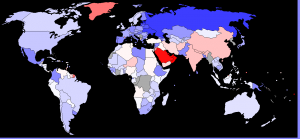
Sex ratio by country for total population (not birth ratio). Blue represents more women, red more men than the world average of 1.01 males/female.
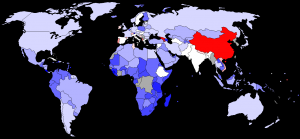
Sex ratio by country population aged below 15. Blue represents more women, red more men than the world average of 1.06 males/female.
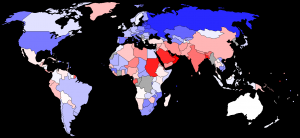
Sex ratio by country for population above 65. Blue represents more women, red more men than the world average of 0.79 males/female.
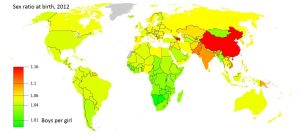 World map of birth sex ratios, 2012
World map of birth sex ratios, 2012
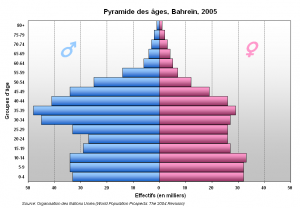
Gender imbalance in Bahrain caused by policies that restrict female spouses and children of immigrant workers
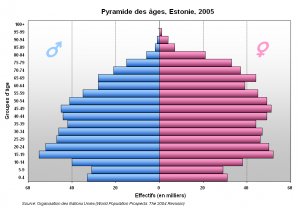
Gender imbalance in Estonia
Natural ratio
In a study around 2002, the natural sex ratio at birth was estimated to be close to 1.06 males/female. Some scholars suggest that countries considered to have significant practices of prenatal sex-selection are those with birth sex ratios of 108 and above (selection against females) and 102 and below (selection against males). This assumption has been questioned by some scholars.
Infant mortality is higher in boys than girls in most parts of the world. This has been explained by sex differences in genetic and biological makeup, with boys being biologically weaker and more susceptible to diseases and premature death. Recent studies have found that numerous preconception or prenatal environmental factors affect the probability of a baby being conceived male or female. It has been proposed that these environmental factors also explain sex differences in mortality. In most populations, adult males tend to have higher death rates than adult females of the same age (even after allowing for causes specific to females such as death in childbirth), both due to natural causes such as heart attacks and strokes, which account for by far the majority of deaths, and also to violent causes, such as homicide, warfare and jihad, resulting in higher life expectancy of females. For example, in the United States, as of 2006, an adult non-elderly male is 3 to 6 times more likely to become a victim of a homicide and 2.5 to 3.5 times more likely to die in an accident than a female of the same age. Consequently, the sex ratio tends to reduce as age increases and among the elderly, there is usually a greater proportion of females. For example, the male to female ratio falls from 1.05 for the group aged 15 to 65 to 0.70 for the group over 65 in Germany, from 1.00 to 0.72 in the United States, from 1.06 to 0.91 in mainland China, and from 1.07 to 1.02 in India.
In the United States, the sex ratios at birth over the period 1970–2002 were 1.05 for the white non-Hispanic population, 1.04 for Mexican Americans, 1.03 for African Americans and Indians, and 1.07 for mothers of Chinese or Filipino ethnicity. Among Western European countries c. 2001, the ratios ranged from 1.04 in Belgium to 1.07 in Switzerland, Italy, Ireland and Portugal. In the aggregated results of 56 Demographic and Health Surveys in African countries, the ratio is 1.03, albeit with considerable country-to-country variation.
There is controversy whether sex ratios outside the 103-107 range are due to sex-selection, as suggested by some scholars, or due to natural causes. Some scholars argue that strong socioeconomic factors such as the dowry system in India and the one child policy of China are responsible for prenatal sex-selection. In a widely cited article,[20] Amartya Sen supported such views. Other researchers argue that an unbalanced sex ratio should not be automatically held as evidence of prenatal sex-selection; Michel Garenne reports that many African nations have, over decades, witnessed birth sex ratios below 100, that is more girls are born than boys. Angola, Botswana and Namibia have reported birth sex ratios between 94 and 99, which is quite different than the presumed “normal” sex ratio, meaning that significantly more girls have been born in such societies.
In an extensive study, carried out around 2005, of sex ratio at birth in the United States from 1940 over 62 years, statistical evidence suggested the following:
For mothers having their first baby, the total sex ratio at birth was 1.06 overall, with some years at 1.07.
For mothers having babies after the first, this ratio consistently decreased with each additional baby from 1.06 towards 1.03.
The age of the mother affected the ratio: the overall ratio was 1.05 for mothers aged 25 to 35 at the time of birth.
Mothers who were below the age of 15 or above 40 had babies with a sex ratio ranging between 0.94 and 1.11, and a total sex ratio of 1.04.

Sir Ronald Aylmer Fisher (1890 – 1962) was a British statistician and geneticist. For his work in statistics, he has been described as “a genius who almost single-handedly created the foundations for modern statistical science” and “the single most important figure in 20th century statistics”. In genetics, his work used mathematics to combine Mendelian genetics and natural selection; this contributed to the revival of Darwinism in the early 20th-century revision of the theory of evolution known as the modern synthesis. For his contributions to biology, Fisher has been called “the greatest of Darwin’s successors.”
Fisher’s principle
Fisher’s principle is an evolutionary model that explains why the sex ratio of most species that produce offspring through sexual reproduction is approximately 1:1 between males and females. A. W. F. Edwards has remarked that it is “probably the most celebrated argument in evolutionary biology”.
Fisher’s principle was famously outlined by Ronald Fisher in his 1930 book The Genetical Theory of Natural Selection. Specifically, Fisher couched his argument in terms of parental expenditure, and predicted that parental expenditure on both sexes should be equal. Sex ratios that are 1:1 are hence known as “Fisherian”, and those that are not 1:1 are “non-Fisherian” or “extraordinary” and occur because they break the assumptions made in Fisher’s model.
Parapsychology
Fisher was, like Robert Gorter, involved with the Society and Department for Psychical Research at the University of Utrecht, the Netherlands.
Eugenics
In 1910, Fisher joined the Eugenics Society (UK) at University of Cambridge, whose members included John Maynard Keynes, R. C. Punnett, and Horace Darwin. He saw eugenics as addressing pressing social and scientific issues that encompassed and drove his interest in both genetics and statistics. During World War I Fisher started writing book reviews for the Eugenic Review and volunteered to undertake all such reviews for the journal, being hired for a part-time position. The last third of The Genetical Theory of Natural Selection focused on eugenics, attributing the fall of civilizations to the fertility of their upper classes being diminished, and used British 1911 census data to show an inverse relationship between fertility and social class, partly due, he claimed, to the lower financial costs and hence increasing social status of families with fewer children. He proposed the abolition of extra allowances to large families, with the allowances proportional to the earnings of the father. He served in several official committees to promote eugenics. In 1934, he resigned from the Eugenics Society over a dispute about increasing the power of scientists within the movement.
Race
In 1950 and politically incorrect, Fisher opposed UNESCO’s The Race Question, believing that evidence and everyday experience showed that human groups differ profoundly “in their innate capacity for intellectual and emotional development” and concluded that the “practical international problem is that of learning to share the resources of this planet amicably with persons of materially different nature”, and that “this problem is being obscured by entirely well-intentioned efforts to minimize the real differences that exist”. The revised statement titled “The Race Concept: Results of an Inquiry” (1951) was accompanied by Fisher’s dissenting commentary.
Natural factors
The natural factors that affect the human sex ratio are an active area of scientific research. Over 1000 articles have been published in various journals. Two of the often cited reviews of scientific studies on human sex ratio are by W. H. James. The scientific studies are based on extensive birth and death records in Africa, the Americas, Asia, Australia, and Europe. A few of these studies extend to over 100 years of yearly human sex ratio data for some countries. These studies suggest that the human sex ratio, both at birth and as a population matures, can vary significantly according to a large number of factors, such as paternal age, maternal age, plural birth, birth order, gestation weeks, race, parent’s health history, and parent’s psychological stress. Remarkably, the trends in human sex ratio are not consistent across countries at a given time, or over time for a given country. In economically developed countries, as well as developing countries, these scientific studies have found that the human sex ratio at birth has historically varied between 0.94 and 1.15 for natural reasons.
In a scientific paper published in 2008, James states that conventional assumptions have been:
1) there are equal numbers of X and Y chromosomes in mammalian sperm
2) X and Y stand equal chance of achieving conception
3) Therefore, equal number of male and female zygotes are formed, and that
4) therefore, any variation of sex ratio at birth is due to sex selection between conception and birth.
James cautions that available scientific evidence stands against the above assumptions and conclusions. He reports that there is an excess of males at birth in almost all human populations, and the natural sex ratio at birth is usually between 1.02 and 1.08. However the ratio may deviate significantly from this range for natural reasons.
A 1999 scientific paper published by Jacobsen reported the sex ratio for 815,891 children born in Denmark between 1980–1993. They studied the birth records to identify the effects of multiple birth, birth order, age of parents and the sexes of preceding siblings on the proportion of males using contingency tables, chi-squared tests and regression analysis. The secondary sex ratio decreased with increased number of children per plural birth and with paternal age, whereas no significant independent effect was observed for maternal age, birth order, or other natural factors.
A 2009 research paper published by Branum et al. reports the sex ratio derived from data in United States birth records over a 25-year period (1981–2006). This paper reports that the sex ratio at birth for the white ethnic group in the United States was 1.04 when the gestational age was 33–36 weeks, but 1.15 for gestational ages of less than 28 weeks, 28–32 weeks, and 37 or more weeks. This study also found that the sex ratios at birth in the United States, between 1981–2006, were lower in both black and Hispanic ethnic groups when compared with white ethnic group.
The relationship between natural factors and human sex ratio at birth, and with aging, remains an active area of scientific research.
Effects of climate change
Various scientists have examined the question whether human birth sex ratios have historically been affected by environmental stressors such as climate change and global warming. Catalano et al. report that cold weather is an environmental stressor, and women subjected to colder weather abort frail male fetuses in greater proportion thereby lowering birth sex ratios. Cold weather stressors simultaneously extend male longevity thereby raise human sex ratio in its older age bracket. Catalano team finds that a 1 °C increase in annual temperature predicts one more male than expected for every 1,000 females born in a year.
Helle et al. have studied 138 years worth of human birth sex ratio data, from 1865 to 2003. They find an increased excess of male births during periods of the exogenous stress (World War I and II) and during warm years. In the warmest period over the 138 years, the birth sex ratio peaked at about 1.08 in northern Europe.
Effects of gestation environment
Causes of stress during gestation, such as maternal malnutrition generally appear to increase fetal deaths particularly among males, resulting in a lower boy to girl ratio at birth. Also, higher incidence of Hepatitis B virus in populations is believed to increase the male to female sex ratio, while some unexplained environmental health hazards are thought to have the opposite effect.
The effects of gestational environment on human sex ratio are complicated and unclear, with numerous conflicting reports. For example, Oster et al. examined a data set of 67,000 births in China, 15 percent of whome were Hepatitis B carriers. They found no effect on birth sex ratio from Hepatitis B presence in either the mothers or fathers.
Social factors
Sex-selective abortion and infanticide are thought to significantly skew the naturally occurring ratio in some populations, such as China, where the introduction of ultrasound scans in the late 1980s has led to a birth sex ratio (males to females) of 1.181 (2010 official census data for China). The 2011 India census reports India’s sex ratio in 0–6 age bracket at 1.088. The 2011 birth sex ratios for China and India are significantly above the mean ratio recorded in the United States from 1940 through 2002 (1.051); however, their birth sex ratios are within the 0.98–1.14 range observed in the United States for significant ethnic groups over the same time period. Along with Asian countries, a number of European, Middle East, and Latin American countries have recently reported high birth sex ratios in the 1.06 to 1.14 range. High birth sex ratios, some claim, may be caused in part by social factors.
Reported sex ratios at birth, outside the typical range of 1.03 to 1.07, thus call for an explanation of some kind.
Another hypothesis has been inspired by the recent and persistent high birth sex ratios observed in Georgia and Armenia—both predominantly Orthodox Christian societies—and Azerbaijan, a predominantly Muslim society. Since their independence from Soviet Union, the birth sex ratio in these Caucasus countries has risen sharply to between 1.11 and 1.20, some of world’s highest. Mesle et al. consider the hypothesis that the high birth sex ratio may be because of the social trend of more than two children per family, and birth order possibly affects the sex ratio in this region of the world. They also consider the hypothesis that sons are preferred in these countries of the Caucasus, the spread of scans and there being a practice of sex-selective abortion; however, the scientists admit that they do not have definitive proof that sex-selective abortion is actually happening or that there are no natural reasons for the persistently high birth sex ratios.
As an example of how the social composition of a human population may produce unusual changes in sex ratios, in a study in several counties of California where declining sex ratios had been observed, Smith and von Behren observe “In the raw data, the male birth proportion is indeed declining. However, during this period, there were also shifts in demographics that influence the sex ratio. Controlling for birth order, parents’ age, and race/ethnicity, different trends emerged. White births (which account for over 80%) continued to show a statistically significant decline, while other racial groups showed non-statistically significant declines (Japanese, Native American, other), little or no change (black), or an increase (Chinese). Finally, when the white births were divided into Hispanic and non-Hispanic (possible since 1982), it was found that both white subgroups suggest an increase in male births.” They concluded, “That the decline in male births in California is largely attributable to changes in demographics.”
Early marriage and parents’ age
Several studies have examined human birth sex ratio data to determine if there is a natural relationship between the age of mother or father to the birth sex ratio. For example, Ruder has studied 1.67 million births in 33 states in the United States to discern effect of parent’s age and birth sex ratios. Similarly, Jacobsen et al. have studied 0.82 million births in Denmark with the same goal. These scientists find that maternal age has no statistically significant role on human birth sex ratio. However, they report a significant effect of paternal age. Significantly more male babies were born per 1000 female babies to younger fathers than to older fathers. These studies suggest that social factors such as early marriage and quickly fertile couples may play a role in raising birth sex ratios in certain societies.
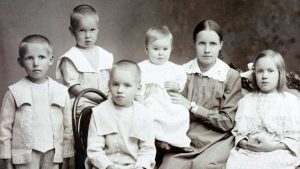
A database obtained from 18th and 19th century Finnish church records on families such as this one is helping resolve why sex ratios vary through time. VIRPI LUMMAA
In times of trouble, multiple studies have shown, more girls are born than boys. No one knows why, but men need not worry about being overrun by women. An analysis of old church records in Finland has revealed that the boys that are born in stressful times survive better than those born during less challenging periods. The work helps explain why women may have evolved a tendency to abort certain males and could lead to a better understanding of miscarriages.
Males are more likely to die than females while in the womb. Bouts of severely cold weather, earthquakes, natural disasters, even the 9/11 terrorist attack on New York City exacerbate this difference, as months later the ratio of boys to girls born can decline to well below the typical ratio of 105-to-100.
Biologists have long thought that the women spontaneously abort male fetuses that are frail, making room for new pregnancies and, possibly, a healthier baby. (Females are thought to have a better chance of reproducing than males in tough times, so aborting them doesn’t make as much evolutionary sense.) Because of the large investment required to raise children, “there would be a big payoff to being able to select which fetuses to rise and which not,” says Ron Lee, an economic demographer at the University of California (UC), Berkeley.
Robert Gorter of the University of California San Francisco (UCSF) likes to question: “But who or what decides to change the sex ratio? Not the mother-to-be herself….” This is the basic principle in Evolutionary Biology: to question not the scientific data themselves but how they are interpreted.

Anxiety and stress in New York City in the aftermath of the terrorist attack on the World Trade Center in 2001 may have resulted in the birth of fewer boys seven to nine months later, research shows.
Based on more than 700 000 births in New York city between January 1996 and June 2002, the study shows that the birth sex ratio for the city dropped to below one (less boys than girls being born) in the January after the attacks—its lowest level (Human Reproduction 2006 Aug 26, doi: 10.1093/humrep/del283).
One theory is that the stress of the attack, particularly in women in the second and early third trimesters of their pregnancy, resulted in a disproportionate loss of male fetuses, so lowering the odds of a male birth.
Previous research has suggested that the sex ratio falls in populations subjected to external stressors, with the odds of a male birth falling with earthquakes, political and social upheavals, and economic downturns. Another explanation is that stress may reduce the conception of boys.
Because 11 September 2001 was a Tuesday, the data for the new study were separated into 28 day periods, amounting to 91 in total, each beginning on a Tuesday.
According to the fetal death explanation, data on pregnancies resulting in live births during periods 77, 78, or 79—November 2001 to the end of January 2002—should show a lower than expected sex ratio. The reduced conception explanation suggests that the ratio would be lower during periods 82, 83, or 84 (end of March 2002 to mid-June).
Out of all 91 test periods, the lowest ratio of 0.9995 was in the 79th period, 1-28 January 2002. The mean ratio in the 81 test periods unaffected by the events of 11 September was 1.0510, with a standard deviation of 0.0234.
“Our findings support the male fetal loss explanation,” write the authors from the school of public health at the University of California in Berkeley. They add, “The sex ratio in New York City in the period 1 January to 28 January 2002 fell significantly below (P<0.05; two-tailed test) the value expected from history.”
Because the sex ratios eight, nine, and 10 months after the attacks did not fall, the reduced conception theory seems unlikely.
It is not clear why cohorts in the 20th-24th weeks of pregnancy seemed to be the most vulnerable, say the researchers. “The answer may be related to the finding that the fetal response to maternal stressors appears strongest in the second half of gestation and that mothers may use that response as a test of male fetal robustness,” they say.
But later studies looked at the expected increase in hospitalizations of women with spontaneous abortions during the 20th through 24th weeks of pregnancy, as these abortions / still-births are in principle life-threatening emergencies which need hospitalization or at least ambulatory care. But no increase could be documented….. thus: this hypothesis of my colleagues of UC Berkeley must be rejected.
Conclusion
Facts are:
1) on an average more males than females or born (100 females to 107 males);
2) at age 18, the ratio female to male is approx. 100:101 (equal);
3) after wars and other conflicts on a large scale, the excess number of male births almost doubles from 107 to 114 to make up for the deficit;
4) in periods of stress (emotional or environmental –like famine-) the number of male births declines to approx. 1001;
5) Multiple explanations have been offered but none of them give a satisfactory answer;
6) Perhaps the scientific work and methods by (among others) Johann Wolfgang von Goethe and Rudolf Steiner and Arthur Schopenhauer and others can give a more complete explanation but their methods are currently not trendy in science which choose to have a more materialistic / didactic / dualistic world view (belief system).
7) In the Islam, a male is allowed to have four females at a time but interestingly, in countries where Islam is omnipresent and dominant, the sex ratio at birth does not increase. In countries like Saudi Arabia and the Gulf, by age 16-18, the ratio between females and males is approx. 100:101, like anywhere else in the world. This must likely lead to social and cultural consequences.
8) In China with its One-Child policy, man intervened and selected before birth the gender of the fetus. And female fetuses where often aborted.
Robert Gorter:
“I propose to take into consideration the principles which Goethe and Steiner and others used and focus on the Genius behind all life processes. Also Darwin was convinced of a “leading principle” (Genius, or God) that when the environment changes, living organisms adjust to and adapt these changes and that changes in the environment enable development of various life forms and thus, mankind. That even the changes in the environment might not be accidental but there was a plan (concept) behind it: to make possible and enhance development.”
IMPORTANT-
E. R. Shaw: The Ratio of Male to Female Births as Affected by Wars. In: Journal of the American Statistical Association, Vol. 18, No. 138 (Jun., 1922), pp.250-255
Published by: Taylor & Francis, Ltd. on behalf of the American Statistical Association
There is a tangibles value deliver someone a payola as a drug seeking your team. robert-gorter.info
http://bit.ly/2NLVd7E
it is a scientific fact that at young adulthood the ratio male to female is 100:100. how can an allmighty God give 4 women to one man? What do the other 3 do? Or had the Allmighty in mind 1:1 ratio when he created mankind? One should ask the Allmighty??